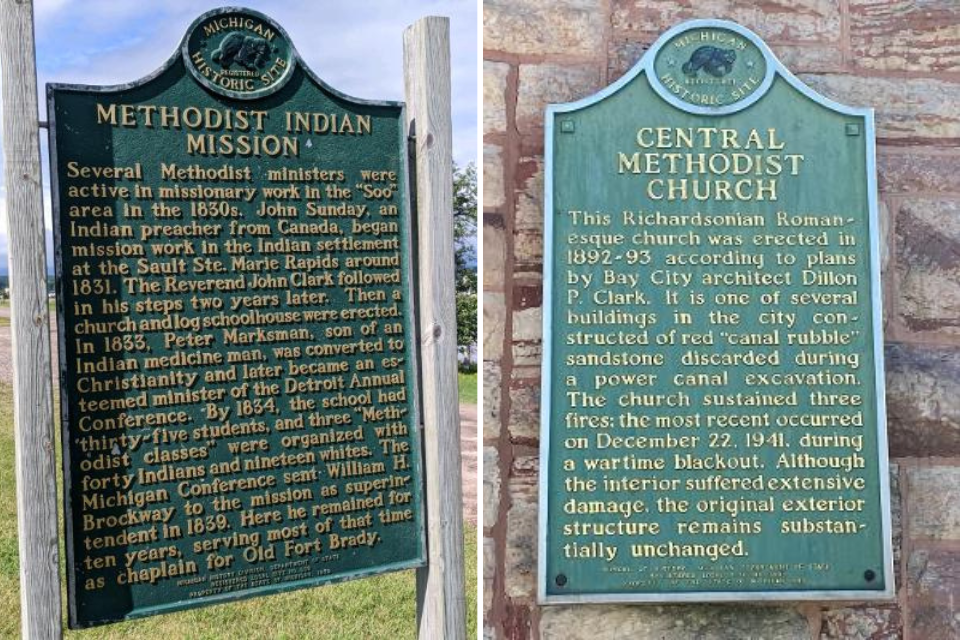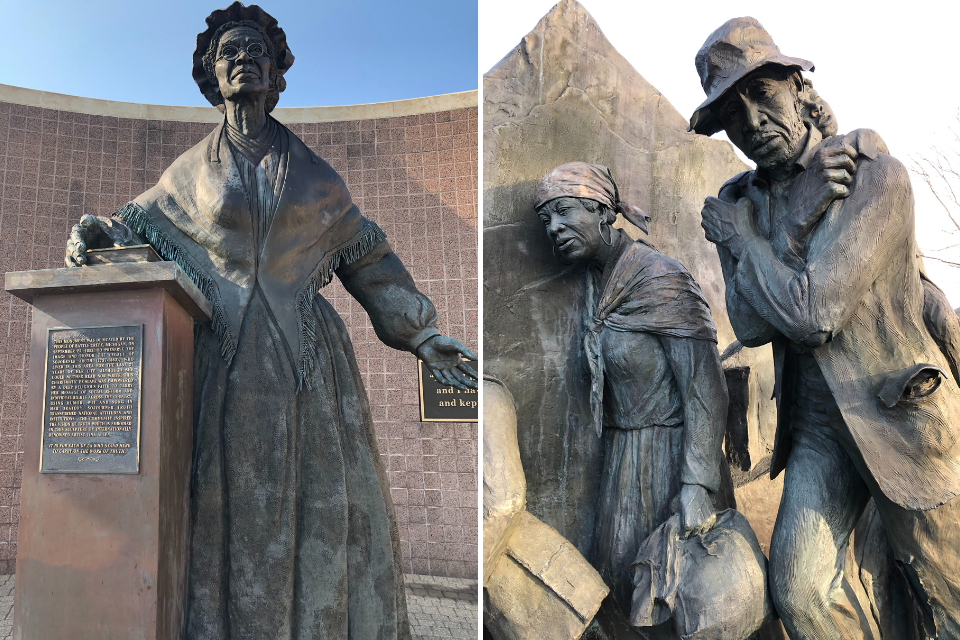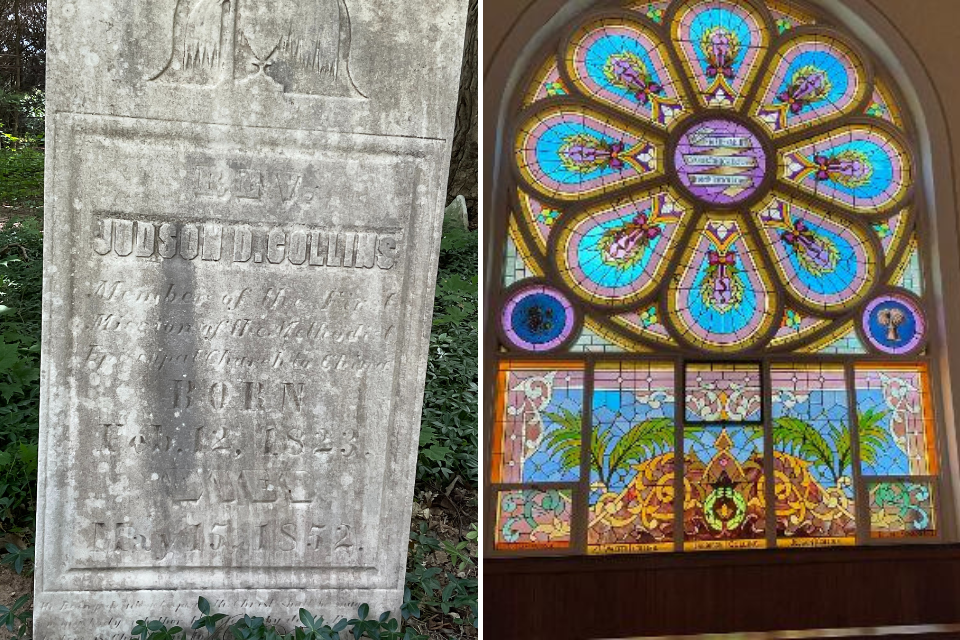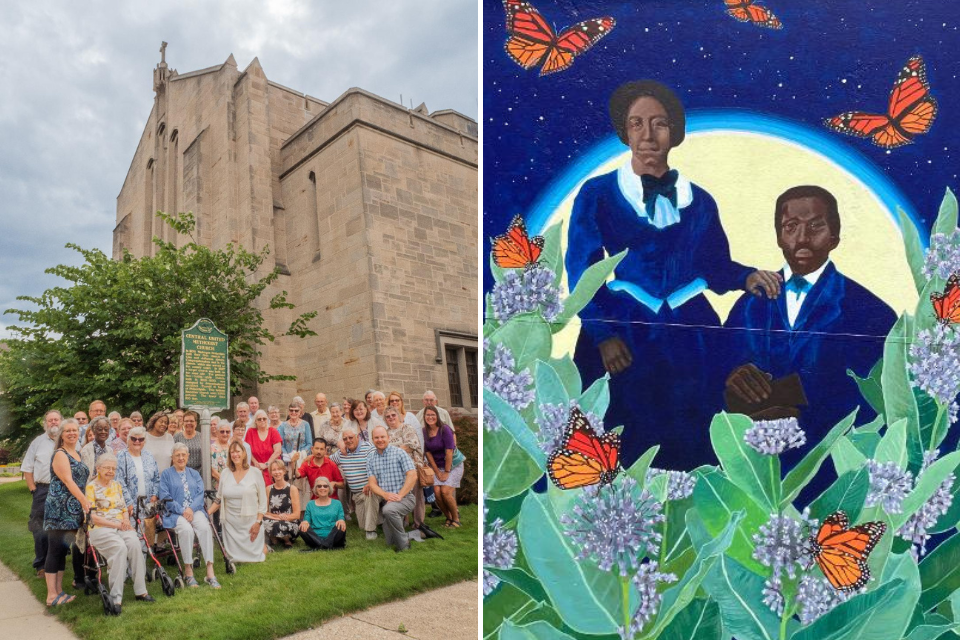Take a virtual road trip through the Great Lakes State visiting key places that have shaped our United Methodist history and continue to form our faith.
GLENN M. WAGNER
Michigan Conference Communications
Christians inspired by John Wesley to live out their love for Jesus in a Methodist way have had an important historical impact across Michigan. This guide will take you to historical places in the state that have a key Methodist connection and introduce you to early forebears who have shaped our denomination’s history. Along the way you’ll also read reflections from Michigan United Methodists today as they speak to how these historical places and people continue to inspire faith.
This first of two articles features the following historical places and markers: (1) the Indian Mission in Sault Ste. Marie, (2) the life and witness of Sojourner Truth memorialized in Battle Creek, (3) the ministry and legacy of Judson Collins and his gravesite in Chelsea, and the faith-shaping ministry of Central United Methodist Church in Muskegon.
Summer is winding down but consider a weekend road trip this fall through the Great Lakes State visiting these important sites from our Michigan Methodist history. Take this guide with you and learn along the way. And if you can’t visit in person, simply use these descriptions and photos to create a virtual road trip experience.
So, jump in your car, or let your imagination take hold, and head to the international border in the Upper Peninsula where Interstate 75 ends. That’s where our historical road trip begins.
Mission to Native Americans at the Soo
Sault Ste. Marie, Michigan’s oldest city, was founded in 1668 and is situated on the northern edge of the Upper Peninsula along the shores of the St. Marys River across from Sault Ste. Marie, Ontario, Canada. Sault Ste. Marie predates the founding of Philadelphia (1682), Washington, D.C. (1790), and Detroit (1701).
According to our Michigan Conference Archives, “About 1831 John Sunday, a Methodist Indian Preacher from Canada, began mission work in the Indian settlement at the Sault Ste. Marie Rapids. In 1832 Rev. John Clark, a missionary from the New York Conference who had just come to Green Bay, heard of the movement at the ‘Soo’ and felt that he should work here. In the spring of 1833, Clark and his family moved to the Soo. The Indians in council responded favorably and the erection of a school house and church began.”
The original location of that historic mission church and school is now occupied by the Sault Ste. Marie Country Club. A historic marker remembering the Methodist mission is located in Rotary Park across Riverside Drive from the Country Club. A second marker featuring a storyboard history of the Methodist mission is also located at Rotary Park about 200 yards from the historical marker on the other side of the trout fishing inlet.
According to archival records, in 1849 the mission with the Ojibway followed the migration of indigenous peoples from Sault Ste. Marie to Naomikong Point in Bay Mills Township forty-two miles west. By 1861 Methodist mission work also continued at Iroquois Point 15 miles west of the Soo, and in 1890 the combined Iroquois and Bay Mills Mission reported 60 members.

According to Rev. Martin Johnston, pastor of Sault Ste. Marie’s Central United Methodist Church and Algonquin United Methodist Church, visitors who come to see the historic markers remembering the original Methodist mission in Rotary Park may also want to stop for a meal at Clyde’s Drive-In restaurant that is located nearby. Johnston notes that Clyde’s is a great place to watch boats on the St. Marys River coming to and from the Soo Locks.
Johnston adds that the gracious and inclusive spirit of that original mission among the indigenous people still inhabits the ministry of Sault Ste. Marie’s Central and Algonquin United Methodist congregations. Their shared mission statement proclaims: “Connecting all people to God by building bridges of caring, outreach, and acceptance.”
Visitors are welcome on Sundays and during the week to visit Sault Ste. Marie’s two historic churches. Central UMC was constructed with stone selected for use during the building of the famous Soo Locks. Locals relate that the church was built first and the town grew up around it.
More travel tips: Central United Methodist Church is located at 111 E. Spruce Street in Sault Ste. Marie. It was listed on the National Register of Historic Places in 1984 and designated a Michigan State Historic Site in 1993. Algonquin United Methodist Church is located at 1604 W. 4th Avenue, about 2.5 miles west of Central UMC.
Sojourner Truth and the Underground Railroad in Battle Creek
Sojourner Truth was born Isabella Baumfree in 1797 as a slave in Swartekill, NY. She escaped with her own infant daughter to freedom in 1826 and went to court to recover her son in 1828, becoming the first African American woman to win such a case against a white man.
In 1827 at the age of 30, she became a Methodist and joined St. James Methodist Episcopal Church in Kingston, NY. In 1843 at the age of 46, Baumfree had a spiritual awakening on June 1, Pentecost Sunday, that inspired her to change her name to Sojourner Truth. She chose the name because she heard the Spirit of God calling on her to preach the truth. She told her friends: “The Spirit calls me, and I must go.”
She commenced traveling and preaching about the abolition of slavery. Taking along only a few possessions in a pillowcase, she traveled north from New York, working her way up through the Connecticut River Valley toward Massachusetts, “testifying the hope that was in her.” During her adult life, Truth associated with multiple religious groups and communities that supported her convictions, including Methodists, Quakers, Millerites, and Seventh-day Adventists. She even lived for a time as part of a commune in Harmonia, MI, a former religious community about six miles west of Battle Creek.
Rev. Dr. Chris Momany, pastor of First United Methodist Church in Dowagiac and abolitionist scholar, remembers that Sojourner Truth devoted much of her adult life to traveling across our country to advocate on behalf of the abolition of slavery, as well as equal rights and suffrage for women and African Americans. During the Civil War, Truth recruited African Americans to serve in the Union Army. She was a persuasive orator, and many of her speeches, including her famous, “Ain’t I a Woman?” speech, have been remembered for posterity.
In 1856 Truth moved to Battle Creek to a home at 38 College Street, which has been replaced by the current private family residence built in 1900. She died in Battle Creek in 1883 at the age of 86, and is buried in Battle Creek’s Oak Hill Cemetery, 255 South Avenue.

The first historical marker honoring Truth was established in Battle Creek in 1935, when a stone memorial was placed in the stone history tower in Monument Park. In 1976 the State of Michigan further recognized her legacy by naming Interstate 194, which connects Interstate 94 to downtown Battle Creek, the Sojourner Truth Downtown Parkway.
Then in 1999, over two hundred years after her birth, a 12-foot-high bronze statue of Sojourner Truth was added to Monument Park in downtown Battle Creek.
Also honoring the work of abolitionists in Battle Creek is the largest monument in the United States dedicated to the Underground Railroad. This is located near the Kellogg House Park, 1 Monroe Street.
Sojourner Truth is the first African American woman to have a statue in our nation’s Capitol Building in Washington D.C. In 2014, Truth was included in Smithsonian magazine’s list of the “100 Most Significant Americans of All Time.”
More travel tips: Oak Hill Cemetery is a four-minute drive south of the Sojourner Truth Monument in Monument Park. Take Main Street south to Willow Street, turn right on Willow to the cemetery on your right. Truth is buried in lot 634 Rt. 9. Click this link for a map of the cemetery showing the exact location of her grave. The Monument to the Underground Railroad is located three-tenths of a mile or a one-minute drive north on Division Steet, left on Van Buren Street, and an immediate left onto Monroe Street from the Sojourner Truth Monument.
Ministry and Legacy of Judson Collins in Chelsea
Judson Collins is an early forebear whose life and witness continues to inspire Michigan United Methodists.
The written history of the First United Methodist Church of Chelsea, MI, devotes the first two paragraphs to Collins noting his beginnings as one of the sons in a faith-filled family. Born in New York, Collins moved with his parents and grew up in Michigan on the family farm near Chelsea. According to Michigan Conference archival records, Collins was converted to the Christian faith in 1837 in Ann Arbor at the age of 14 as a result of the preaching of Elijah Pilcher.
In 1841 when Collins was 18, the University of Michigan opened in Ann Arbor and Collins enrolled as a member of the first class, graduating in 1845 as one of twelve members of the first graduating class. Daily chapel services and a college assignment to write a paper about a missionary to India helped Collins decide to enter service as the first Michigan Methodist missionary to China.
For a year after graduating from the University of Michigan, Collins taught at Albion College while continuing to request the bishop and the conference mission board for an appointment to serve as a missionary to China. The mission board explained that there was no current mission to China and no money to begin one, and then suggested that, at 23 years of age, Collins was too young for such a mission. Collins replied that Martin Luther was not much older when he defied the Church of Rome, Napoleon was only 25 when he conquered Italy, and Isaac Newton was just 25 when he described the theory of gravity. Collins’ request for missionary service inspired people to raise support, and in August of 1846 when he was 24, he received his appointment. He moved to Fuzhou, China, learned Chinese, and served as a missionary there for four years before returning to Michigan with failing health. Collins died in Michigan in 1852 at the age of 29.
Judson Collins is buried north of Chelsea in a family cemetery that contains graves of two of his other three brothers who also served as distinguished Methodist pastors and missionaries. The Collins family cemetery, which is on land that was originally part of the Collins family farm, is a registered Michigan historical site. This private cemetery is open to public visits.

Rev. Joy Barrett, pastor of Chelsea: First, notes that the first pastor to help organize the Chelsea church arrived there in 1853, a year after Collins’ death. By 1855 most of the new families coming to the village—one that had grown to 200 people—were Methodist. One of the stained glass windows in the sanctuary at Chelsea: First is dedicated in memory of the Collins family.
On the 100th anniversary of Judson Collins’ death, in 1952, one thousand people gathered at First Methodist Church of Ann Arbor for a special service of worship to commemorate his life and to highlight continuing mission work in China. The centennial also coincided with the effort by Detroit Conference Methodists to grow church camping ministry, particularly for children in the greater Detroit metropolitan area to experience fresh air and learn about the love of Jesus through camping. Acreage formerly owned by the Civilian Conservation Corps adjacent to W.J. Hayes State Park along the shores of Wamplers Lake near Onsted, MI, was purchased from the Jewish Fresh Air Society and renamed the Judson Collins Camp.
For 67 years, from its opening in 1952 until the camp officially closed at the end of 2019, Judson Collins Camp offered campers of all ages an opportunity to experience the beauty of nature and to grow in the love of Jesus. Long-time director Rev. Mark Johnston, who served as camp manager from 1982-1996, notes that the camp shared Judson Collins’ values with campers. “We provided basic no-frills shelter, meals, fun, and great experience of God’s creation. We helped our campers, many of them children from the inner city, to learn about what is needed for life. We were an inclusive camp and provided a safe place for people to meet others from different races and cultures. We wanted our campers to learn to love Jesus and all of God’s people. We were proud of our international camp staff and the cultural exchange which enabled our campers to meet people from other parts of the world who shared their faith in Jesus. We also raised scholarships to help make camp affordable for children and youth from less fortunate circumstances.”
More travel tips: The grave and gravestone for Judson Collins is found in the family cemetery on the farm on which he was brought up in the hills north of Chelsea. Proceed northwest from Chelsea on M-52 about 6 miles to Ropeke Road, turn north (right) about 2½ miles to a sign noting the location of the Judson Collins grave. Turn right and walk a primitive roadway through a field, one-eighth of a mile, to the little farm cemetery overlooking Joslin Lake to the east.
Witness of Central United Methodist Church in Muskegon
In the conference archival listing of designated Michigan Methodist historical sites, Central United Methodist Church in Muskegon is currently the lone representative in West Michigan.
According to Central UMC’s pastor Rev. Rob Cook, the history of the church is a testament to faithful people loving God and neighbor, encountering great and unexpected tests of faith, and experiencing the amazing grace of God to help them through those challenges.
Cook credits the important history of the church chronicled by Thomas Begley, The Builders: The Identity and Witness of Central United Methodist of Muskegon, for helping the congregation continue to find strength in the lessons of the past as it faces new challenges in the present and lives toward the future.
Central United Methodist church history remembers that the first service was held in 1843 in the dining room of Martin Ryerson’s boarding house.
Central UMC also credits the ministry and preaching of an African American farm couple, Abner and Mary Bennett. From 1851-1855, the Bennetts walked 17 miles (almost six hours) each Saturday south from their White Lake farm (near Whitehall) to Muskegon to help lead Sunday worship, and then walk back to their farm near the mouth of the White River. A Methodist Deacon, Abner preached often in Muskegon. He and Mary are also credited with helping to start a number of churches in West Michigan.
Montague United Methodist Church credits the pioneering witness of the Bennetts in their church history: “From his farm near the Old Channel of White Lake, Bennett was an itinerant minister who spread the gospel throughout the pioneer settlements of western Michigan and created the White River Circuit, in 1855, which included small congregations from as far north as Little Point Sable, as far south as Muskegon, and possibly as far east as Newaygo.” A 2010 Muskegon Chronicle editorial also says of the Bennetts: “Their home also is believed to have been a stop on the Underground Railroad, which helped slaves find their way to freedom.”

The first church building for Methodists in Muskegon of wood construction was built in 1857. The local lumber industry had been flourishing since 1837. The new church was a great help for worship and witness, but in 1861 the Civil War began, and the local lumber economy suffered as demand slowed. The trials of the war demanded a deepening of faith.
After the Civil War ended in 1865, prosperity returned to Muskegon. The members of the church decided to build a newer and bigger house of worship out of red brick in 1888 to accommodate a growing congregation. But the Central Methodist congregation soon faced new economic and relational stresses caused by a tragic fire in Muskegon on May 16, 1891, that destroyed 17 city blocks. The panic of 1893, which led to massive unemployment, and the lumber industry in West Michigan, which began to fail as a result of widespread deforestation causing nine lumber mills to close between 1890 and 1900, burdened the church’s finances with unpayable indebtedness.
The congregation grew again in ministry and in size during the prosperous years of the early 1920s, prompting church leaders to build the current magnificent stone church with lofty ceilings and stained glass windows. The original cost was $300,000, but the congregation went into debt for their building without worry. Their first service in the new building was held on October 6, 1929. Then the stock market crashed later that month beginning the Great Depression, which brought the church to the brink of foreclosure.
Central UMC’s history remembers the financial stresses: “Predictably, the depression took its toll on Central Methodist Episcopal Church until a total debt of $200,000 was amassed. In 1934, five families mortgaged their homes and donated the proceeds to stave off foreclosure; but even with that sacrificial help, it took another 10 years to completely retire the debt in 1944.”
Rev. Melanie Young, who served as an associate pastor at Central UMC from 1994-1996, remembers that Central had a hand in starting other Methodist congregations in the Muskegon area, and that the very first “associate ministers” appointed to the church were given the primary task of serving as the pastors for these fledgling “associated congregations.”
In 2015 Central UMC purchased the adjacent building of the First Church of Christ Scientist in order to turn it into a community center with space for other community ministry partners to help serve the people of Muskegon.
As Pastor Cook reflected on the history of his congregation while facing current church challenges brought on by a global pandemic, he offered words of hope grounded in a clear history of enduring faith helping the church to meet challenges. He noted that the answer to such times lies in growing relationships, embodying love, partnering with neighbors to meet real community needs, and continuing to trust in God. Cook is grateful for the significant history of his congregation that leads him, like the long walk of the congregation’s earliest founders, to continue on the path of faithfulness trusting in God whose love is greater than our worries.
More travel tips: Central United Methodist is located at 1011 2nd Street in downtown Muskegon, at the corner of 2nd Street and Muskegon Avenue. Do something out of the ordinary: Get off US-31 and take two-lane roads from Whitehall to Muskegon through rural farmland to see what that long walk might have looked like for Abner and Mary Bennett. Use an online map tool to find your way, or turn off the GPS and see where the Spirit leads.
Last Updated on December 20, 2023

